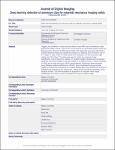Deep Learning Detection of Aneurysm Clips for Magnetic Resonance Imaging Safety
| dc.contributor.author | Courtman, M | |
| dc.contributor.author | Kim, D | |
| dc.contributor.author | Wit, H | |
| dc.contributor.author | Wang, H | |
| dc.contributor.author | Sun, L | |
| dc.contributor.author | Ifeachor, E | |
| dc.contributor.author | Mullin, S | |
| dc.contributor.author | Thurston, M | |
| dc.date.accessioned | 2023-11-13T13:12:28Z | |
| dc.date.available | 2023-11-13T13:12:28Z | |
| dc.date.issued | 2024-01-12 | |
| dc.identifier.issn | 1618-727X | |
| dc.identifier.issn | 2948-2933 | |
| dc.identifier.uri | https://pearl.plymouth.ac.uk/handle/10026.1/21636 | |
| dc.description.abstract |
Flagging the presence of metal devices before a head MRI scan is essential to allow appropriate safety checks. There is an unmet need for an automated system which can flag aneurysm clips prior to MRI appointments. We assess the accuracy with which a machine learning model can classify the presence or absence of an aneurysm clip on CT images. A total of 280 CT head scans were collected, 140 with aneurysm clips visible and 140 without. The data were used to retrain a pre-trained image classification neural network to classify CT localizer images. Models were developed using fivefold cross-validation and then tested on a holdout test set. A mean sensitivity of 100% and a mean accuracy of 82% were achieved. Predictions were explained using SHapley Additive exPlanations (SHAP), which highlighted that appropriate regions of interest were informing the models. Models were also trained from scratch to classify three-dimensional CT head scans. These did not exceed the sensitivity of the localizer models. This work illustrates an application of computer vision image classification to enhance current processes and improve patient safety. | |
| dc.format.extent | 72-80 | |
| dc.format.medium | Print-Electronic | |
| dc.language | en | |
| dc.publisher | Springer | |
| dc.subject | Aneurysm clips | |
| dc.subject | Artificial intelligence | |
| dc.subject | CT | |
| dc.subject | Deep learning | |
| dc.subject | MRI | |
| dc.subject | Patient safety | |
| dc.title | Deep Learning Detection of Aneurysm Clips for Magnetic Resonance Imaging Safety | |
| dc.type | journal-article | |
| dc.type | Journal Article | |
| plymouth.author-url | https://www.ncbi.nlm.nih.gov/pubmed/38343241 | |
| plymouth.issue | 1 | |
| plymouth.volume | 37 | |
| plymouth.publication-status | Published online | |
| plymouth.journal | Journal of Digital Imaging | |
| dc.identifier.doi | 10.1007/s10278-023-00932-8 | |
| plymouth.organisational-group | |Plymouth | |
| plymouth.organisational-group | |Plymouth|Research Groups | |
| plymouth.organisational-group | |Plymouth|Faculty of Science and Engineering | |
| plymouth.organisational-group | |Plymouth|Users by role | |
| plymouth.organisational-group | |Plymouth|Users by role|Academics | |
| plymouth.organisational-group | |Plymouth|Users by role|Post-Graduate Research Students | |
| plymouth.organisational-group | |Plymouth|Research Groups|FoH - Applied Parkinson's Research | |
| dc.publisher.place | Switzerland | |
| dcterms.dateAccepted | 2023-10-19 | |
| dc.date.updated | 2023-11-13T13:12:22Z | |
| dc.rights.embargodate | 2024-1-31 | |
| dc.identifier.eissn | 2948-2933 | |
| rioxxterms.versionofrecord | 10.1007/s10278-023-00932-8 |


